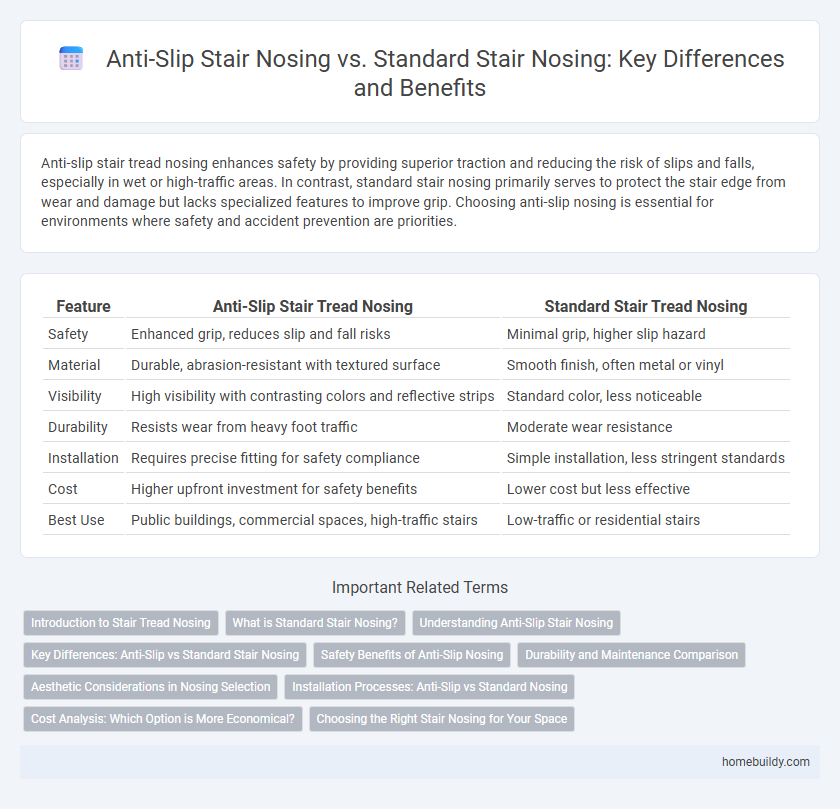Anti-slip stair tread nosing enhances safety by providing superior traction and reducing the risk of slips and falls, especially in wet or high-traffic areas. In contrast, standard stair nosing primarily serves to protect the stair edge from wear and damage but lacks specialized features to improve grip. Choosing anti-slip nosing is essential for environments where safety and accident prevention are priorities.
Table of Comparison
| Feature | Anti-Slip Stair Tread Nosing | Standard Stair Tread Nosing |
|---|---|---|
| Safety | Enhanced grip, reduces slip and fall risks | Minimal grip, higher slip hazard |
| Material | Durable, abrasion-resistant with textured surface | Smooth finish, often metal or vinyl |
| Visibility | High visibility with contrasting colors and reflective strips | Standard color, less noticeable |
| Durability | Resists wear from heavy foot traffic | Moderate wear resistance |
| Installation | Requires precise fitting for safety compliance | Simple installation, less stringent standards |
| Cost | Higher upfront investment for safety benefits | Lower cost but less effective |
| Best Use | Public buildings, commercial spaces, high-traffic stairs | Low-traffic or residential stairs |
Introduction to Stair Tread Nosing
Stair tread nosing enhances safety by providing a visible edge and increasing traction on stair steps, crucial for preventing slips and falls. Anti-slip nosing incorporates materials like abrasive strips or rubber inserts to improve grip, outperforming standard stair nosing that primarily offers edge protection and aesthetic finish. Selecting anti-slip nosing is essential in high-traffic or wet environments to comply with safety regulations and reduce accident risks.
What is Standard Stair Nosing?
Standard stair nosing is a protective strip installed on the edge of stair treads to enhance durability and prevent wear. Typically made from materials like aluminum, rubber, or wood, it provides a clean finish and structural reinforcement but lacks specialized anti-slip features. Unlike anti-slip nosing, standard stair nosing primarily focuses on aesthetic and edge protection rather than maximizing traction or safety on stairs.
Understanding Anti-Slip Stair Nosing
Anti-slip stair tread nosing incorporates textured or abrasive materials designed to increase traction and prevent slips, making it essential for safety in high-traffic or wet environments. Unlike standard stair nosing, which primarily protects stair edges from wear and adds aesthetic appeal, anti-slip nosing actively reduces slip hazards by enhancing grip. Selecting high-quality anti-slip nosing with certifications such as ADA compliance or slip resistance ratings ensures optimal performance and durability.
Key Differences: Anti-Slip vs Standard Stair Nosing
Anti-slip stair tread nosing features textured surfaces or embedded abrasive materials to significantly enhance traction and reduce slip hazards, making it ideal for high-traffic or wet areas. Standard stair nosing primarily provides edge protection and aesthetic finish without specialized slip-resistant properties, focusing on durability and structural integrity. The key difference lies in safety performance, where anti-slip nosing prioritizes user safety through improved grip, while standard nosing emphasizes wear resistance and visual alignment with stair design.
Safety Benefits of Anti-Slip Nosing
Anti-slip stair tread nosing significantly enhances safety by providing increased traction, reducing the risk of slips and falls on both wet and dry surfaces. Unlike standard stair nosing, anti-slip options often incorporate abrasive materials or textured finishes that improve grip and visibility, which is crucial in high-traffic or low-light areas. Implementing anti-slip nosing contributes to compliance with safety regulations and minimizes accident-related liabilities in residential and commercial buildings.
Durability and Maintenance Comparison
Anti-slip stair tread nosing typically features materials like rubber or abrasive strips that enhance grip while withstanding heavy foot traffic, resulting in higher durability compared to standard stair nosing made from basic aluminum or plastic. Maintenance of anti-slip nosing involves regular cleaning to prevent dirt buildup in textured surfaces, but it generally requires less frequent replacement due to its robust construction. Standard stair nosing often shows quicker wear and tear, demanding more frequent inspections and potential replacements to maintain safety and functionality.
Aesthetic Considerations in Nosing Selection
Anti-slip stair tread nosing offers enhanced safety features through textured surfaces or abrasive strips, which may impact the overall aesthetic by introducing visible grip elements. Standard stair nosing typically prioritizes a seamless appearance, blending smoothly with the stair design for a cleaner, more uniform look. Selecting between anti-slip and standard nosing requires balancing safety requirements with desired visual appeal in stair design.
Installation Processes: Anti-Slip vs Standard Nosing
Anti-slip stair tread nosing requires precise surface preparation and secure fastening to ensure maximum grip and compliance with safety standards, often involving adhesive bonding combined with mechanical fixing. Standard stair nosing installation is typically simpler, relying mainly on screws or nails without the need for specialized adhesives or surface treatments. The complexity of anti-slip nosing installation ensures enhanced durability and slip resistance essential for high-traffic or wet environments.
Cost Analysis: Which Option is More Economical?
Anti-slip stair tread nosing typically incurs higher initial costs due to specialized materials like rubber, metal inserts, or abrasive coatings designed to enhance safety and durability. Standard stair nosing uses basic materials such as vinyl or aluminum, making it more economical upfront but potentially requiring more frequent replacement due to wear and safety concerns. Considering long-term expenses, anti-slip nosing often proves more cost-effective by reducing accident-related costs and maintenance frequency, despite its higher upfront price.
Choosing the Right Stair Nosing for Your Space
Anti-slip stair tread nosing offers enhanced safety by providing superior grip and reducing the risk of slips and falls, making it ideal for high-traffic or commercial areas. Standard stair nosing primarily protects the stairs' edge and increases durability but lacks specialized traction features, suitable for low-traffic or residential spaces. Selecting the right stair nosing depends on factors like foot traffic, safety requirements, and environmental conditions to ensure optimal performance and compliance with building codes.
Anti-slip nosing vs Standard stair nosing Infographic

 homebuildy.com
homebuildy.com